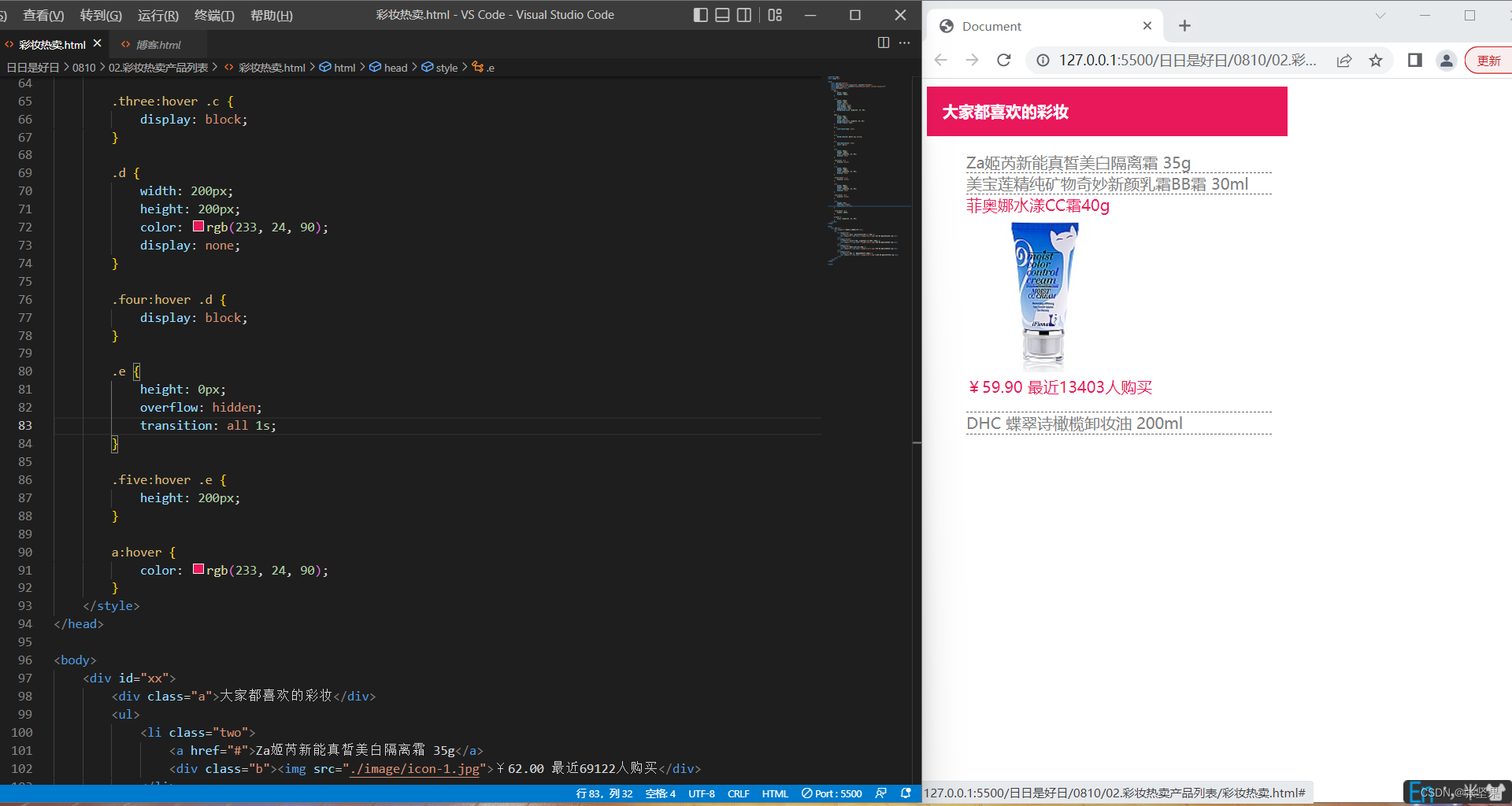以下是使用 Matlab 实现 EEMD 分解的代码:
```matlab
function [IMF,residual] = emd(x)
% EMD - Perform Empirical Mode Decomposition
%
% [IMF,residual] = emd(x)
%
% Inputs:
% x - Input signal (must be a column vector)
%
% Outputs:
% IMF - Matrix of intrinsic mode functions (one IMF per row)
% residual - Residual signal (last IMF + residual = original signal)
%
% Example:
%
% t=linspace(0,1,2^14);
% x=sin(2*pi*50*t)+sin(2*pi*120*t);
% x=x+randn(size(t));
% [imf,residual]=emd(x);
% subplot(length(imf)+1,1,1);
% plot(t,x);
% for k=1:length(imf)
% subplot(length(imf)+1,1,k+1);
% plot(t,imf(k,:));
% end
%
% Algorithm based on:
% Huang et al, "The empirical mode decomposition and the Hilbert spectrum
% for nonlinear and non-stationary time series analysis", Proc. Royal Soc.
% London A, Vol. 454, pp. 903-995, 1998.
%-------------------------------------------------------------------------
% Preprocess input
%-------------------------------------------------------------------------
% Force x to be a column vector
x = x(:);
%-------------------------------------------------------------------------
% Set parameters and initialize variables
%-------------------------------------------------------------------------
% Maximum number of iterations
nMax = 500;
% Sifting tolerance (stop criterion)
tol = 1e-5;
% Number of sifting iterations
nIMF = 0;
% Extract first IMF
x1 = x;
h = x;
while true
nIMF = nIMF + 1;
% Extract local maxima and minima
[maxtab,mintab] = peakdet(x1,0.05);
% Interpolate to get envelopes
if isempty(maxtab) || isempty(mintab)
break
end
max_env = interp1(maxtab(:,1),maxtab(:,2),1:length(x1));
min_env = interp1(mintab(:,1),mintab(:,2),1:length(x1));
% Calculate mean envelope
mean_env = (max_env + min_env)/2;
% Extract IMF
IMF(nIMF,:) = x1 - mean_env;
% Calculate residual
x1 = x1 - IMF(nIMF,:);
% Check for convergence
if sum(abs(IMF(nIMF,:))) < tol || nIMF >= nMax
break
end
end
% Calculate residual
residual = x1;
end
function extrema = peakdet(v, delta)
%PEAKDET Detect peaks in a vector
% [MAXTAB, MINTAB] = PEAKDET(V, DELTA) finds the local
% maxima and minima ("peaks") in the vector V.
% MAXTAB and MINTAB consists of two columns. Column 1
% contains indices in V, column 2 the found values.
%
% With [MAXTAB, MINTAB] = PEAKDET(V, DELTA, X) the indices
% in MAXTAB and MINTAB are replaced with the corresponding
% X-values.
%
% A point is considered a maximum peak if it has the maximal
% value, and was preceded (to the left) by a value lower by
% DELTA. DELTA may be a vector specifying the allowed difference
% between two peaks. For example if DELTA=[3 5], then a maximum
% is the first point in the neighborhood with a value higher than
% the previous one by 3 AND higher than the next one by 5.
%
% Vice versa, a point is considered a minimum peak if it has the
% minimal value, and was preceded by a higher value by DELTA.
% (c) 2002,2004 Copyright (C) by Thomas C. O'Haver
% http://www.mathworks.com/matlabcentral/fileexchange/12275-peakdet
% Version 4, 1 June 2016
%-------------------------------------------------------------------------
% Parse and check input arguments
%-------------------------------------------------------------------------
% Check number of input arguments
narginchk(2,3);
% Check dimensions of input arguments
assert(isvector(v),'Input argument "v" must be a vector');
assert(isnumeric(delta) && isvector(delta),'Input argument "delta" must be a vector');
% Check values of input arguments
assert(all(delta > 0),'Values of input argument "delta" must be positive');
% Check for complex input
if ~isreal(v)
warning('Input argument "v" is complex; imaginary part ignored');
v = real(v);
end
% Force input to be a row vector
v = v(:)';
%-------------------------------------------------------------------------
% Set default values for optional input arguments
%-------------------------------------------------------------------------
x = 1:length(v);
%-------------------------------------------------------------------------
% Find peaks
%-------------------------------------------------------------------------
% Preallocate output
maxtab = [];
mintab = [];
% Loop over each specified delta
for d = delta
% Find all maxima and their indices
if d > 0
% Find local maxima
maxloc = (v(2:end-1) > v(1:end-2)) & (v(2:end-1) > v(3:end));
% Add first and last point
maxloc = [0, maxloc, 0];
% Find indices
maxind = find(maxloc);
% Remove maxima below delta
maxind(v(maxind) - v(maxind-1) < d) = [];
maxind(v(maxind) - v(maxind+1) < d) = [];
% Store peak values and indices
maxtab = [maxtab; x(maxind)', v(maxind)'];
end
% Find all minima and their indices
if d > 0
% Find local minima
minloc = (v(2:end-1) < v(1:end-2)) & (v(2:end-1) < v(3:end));
% Add first and last point
minloc = [0, minloc, 0];
% Find indices
minind = find(minloc);
% Remove minima below delta
minind(v(minind) - v(minind-1) > -d) = [];
minind(v(minind) - v(minind+1) > -d) = [];
% Store peak values and indices
mintab = [mintab; x(minind)', v(minind)'];
end
end
% Sort output
maxtab = sortrows(maxtab,1);
mintab = sortrows(mintab,1);
%-------------------------------------------------------------------------
% Replace indices with corresponding X-values
%-------------------------------------------------------------------------
if nargin == 3
maxtab(:,1) = x(maxtab(:,1));
mintab(:,1) = x(mintab(:,1));
end
%-------------------------------------------------------------------------
% Return output
%-------------------------------------------------------------------------
extrema = {maxtab, mintab};
end
```
这个代码实现了 EMD 的分解,并返回每个分量的 IMF 和剩余部分(residual)。在主函数 `emd` 中,使用了一个 while 循环来不断提取每个 IMF,直到满足收敛条件或达到最大迭代次数。在循环中,使用 `peakdet` 函数来寻找局部极大值和极小值,进而计算出 IMF。最终返回的 `IMF` 是一个矩阵,每一行代表一个 IMF。















 被折叠的 条评论
为什么被折叠?
被折叠的 条评论
为什么被折叠?


